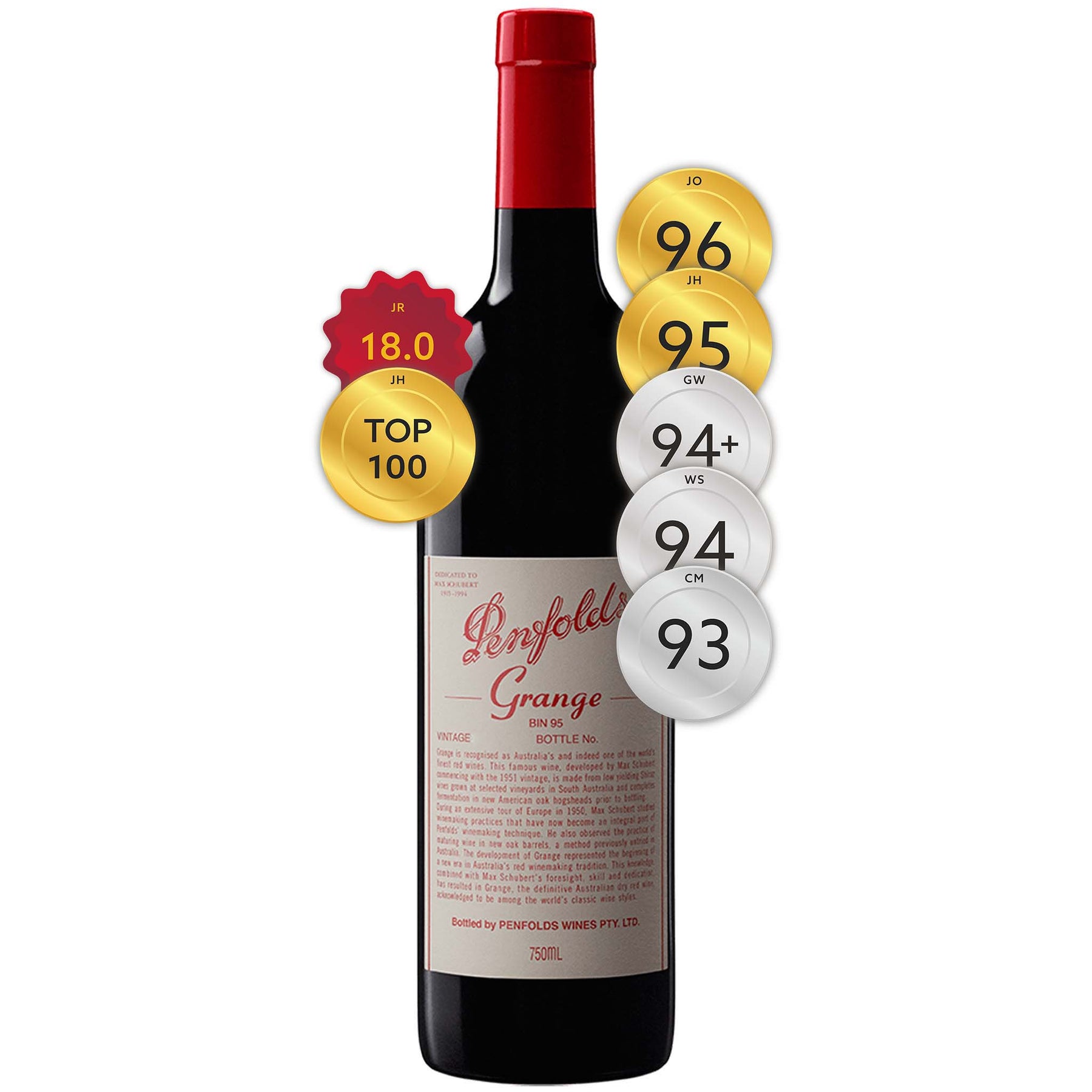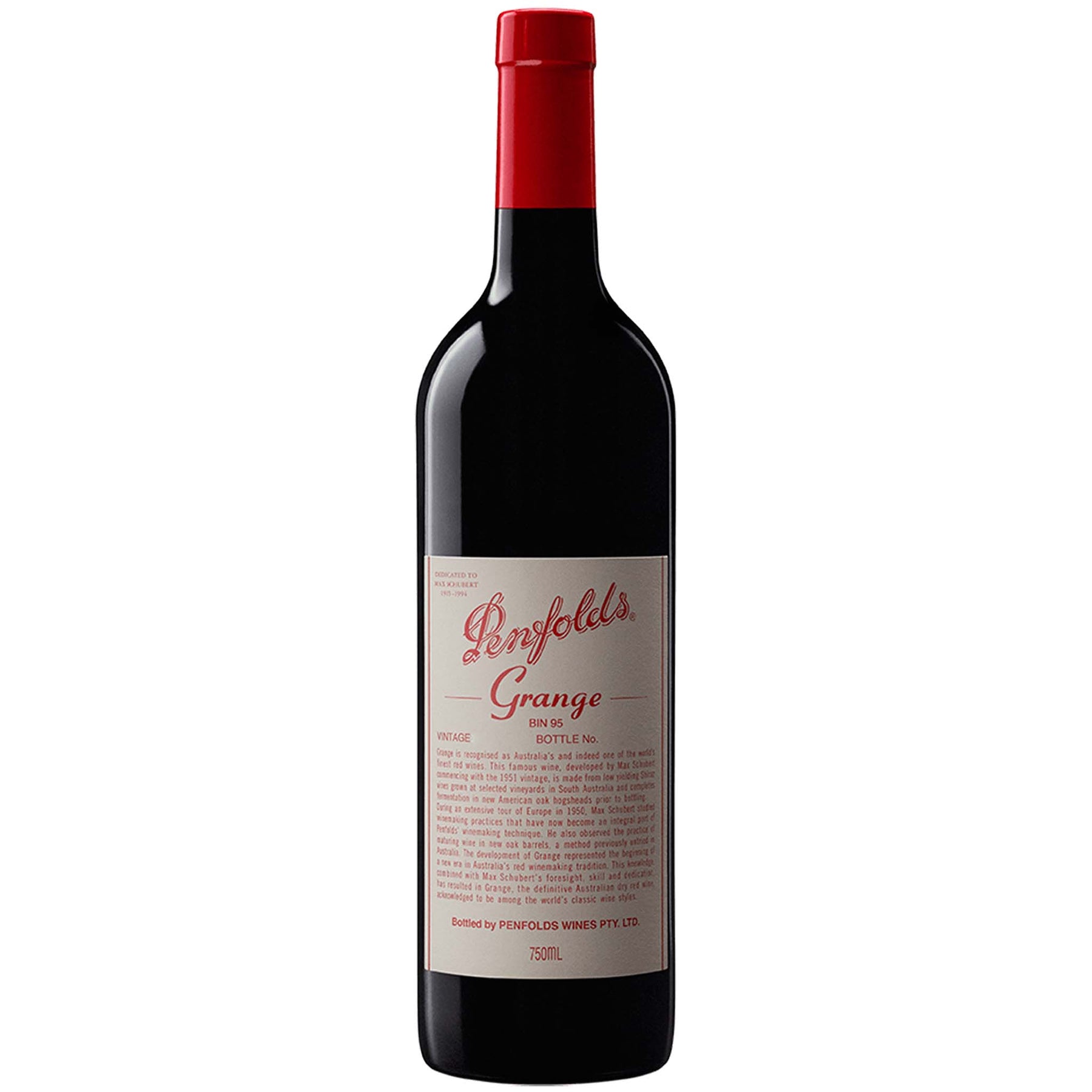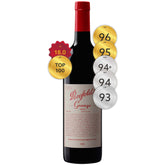

Penfolds Bin 95 Grange 2003
Style: Red Wine
Varieties: Shiraz (97%), Cabernet Sauvignon (3%)
Closure: Cork
Penfolds Bin 95 Grange 2003
Warehouse
34 Redland Drive
Vermont VIC 3133
Australia
Critic Score: 96
Alcohol: 14.5 %
Size: 750 ml
Drink by: 2035
James Halliday Top 100 Wines of 2008
Penfolds Bin 95 Grange Shiraz is Australia's most famous wine with a reputation for superb fruit complexity and flavour richness. It is the most powerful expression of Penfolds multi-vineyard, multi-district blending philosophy and is officially listed as a Heritage Icon of South Australia. One of the world's great wines.
"Rich, complex and evocative, this has plenty of flavor packed into a beautifully balanced package." Harvey Steiman
The 2003 Penfolds Grange is a blend of 97% shiraz and 3% cabernet sauvignon from premium vineyards in the Barossa Valley, McLaren Vale, Langhorne Creek, Coonawarra and Magill Estate (Adelaide). The wine was matured for 15 months in American oak hogsheads (100% new).
"Deep red. Nose: Captivating, complex, complete. Unravelling aromatics unfurl with air - blue fruit notes entwined with barrel ferment and maturation elements; nothing singular, always in tandem. Sweet soy, cola and quince paste high notes escape from an ethereal layer (aniseed, fennel and fresh treacle ginger pudding) wafting above. Palate: Dark and liqueur chocolate, laced with Moroccan spices. An underlying tar/graphite blackness is lifted by derived fruit/quince pie flavours - a few years earlier they may have been more brashly varietal and elemental. Pronounced tannins sweep across the palate, although they are certainly part of the wine, never obtrusive. Long, layered and compelling, this wine is at the spicier end of the Grange spectrum." Peter Gago - Penfolds Chief Winemaker
Expert reviews
"A very ripe, assertive, profoundly structured and traditional warm year Grange whose dark, brooding and brambly fruit and lavish oak are supported by drying, firm and chalky tannin. It's still a bruising young wine, with a surprisingly floral and heady, jasmine-like bouquet and dense layers of blackberries, blueberries, cassis and dark plums backed by smoky, meaty, dark chocolate and cedary influences. As it opens further, nuances of treacle, aniseed and graphite slowly emerge. Firm and dense, its palate simply drips with concentrated flavour, finishing with the length and balance expected of this label." Jeremy Oliver - 96 points
"To be frank, I agonised over the inclusion of this wine, which is not in the same class as the 2002 or the forthcoming '04, '05 and '06 (a brilliant trio). But it is Australia's iconic red wine, and will improve out of sight over the next 20 years. Deep and bright colour; density and structure; the fruit is rich, but not spongy or dead. Ultra careful selection. Drink 2015-2030 (leave it in the cellar)." James Halliday, Halliday Wine Companion - 95 points and Top 100 Wines of 2008
"Dark crimson. Heady sweetness on the nose and then very cool on the palate – really tight and fairly tough at this stage. Dry finish. No sign of the obvious syrup and alcohol that usually characterises Grange for me at all! Very introvert at this stage. Presumably quite a deliberate attempt to counteract this vintage's reputation for extreme head and alcohol. I remember tasting young Grange in the late 1980s and the brilliant pink/purple would stain the inside of the glass the way that it does with young vintage port. Not so this wine. When I went back to it a second time the wine, admittedly in a pretty empty bottle (see notes on St Henri above) had opened out considerably to show a much more complex bouquet than any of the other wines here. Very, very well integrated oak, mellow notes of roast meat (oh no, sorry, that was the St Henri), wonderfully rich, flattering fruit caresses the front palate and then the tarry notes bite on the finish. There's just the merest hint of heat on the finish. But again, Gago has made this beautifully. Maybe the tannins are a little drying on the finish, and the vintage's reputation is unlikely to make this one of the saleroom classics, but it's difficult to see how a better Grange could have been made in 2003. 14.5%." Jancis Robinson MW, JancisRobinson.com -18/20 points
"Supple, ripe and generous with its blueberry, plum and mocha flavors,riding easily over finely wrought tannins and extending into the long, expressive finish. Rich, complex and evocative, this has plenty of flavor packed into a beautifully balanced package. Drink now through 2020." Harvey Steiman, Wine Spectator - 94 points
"As with all Grange the aromatics are layered and complex with this vintage offering a whole raft of interesting things to smell. It's showing a touch of char, brown spices, blackberry, coconut, liquorice, aniseed, soy sauce, camphor and fruit cake in and amongst other things. Seek and ye shall find but the overall impression over three days tasting is of a rich darkly fruited wine backed with liberal high class oak that smells terrific. On the palate full bodied and bulging with powerful dark tarry fruit, mince pie, dark chocolate, dry spices, aniseed and plenty of perfumed cedary oak. It maintains a good level of freshness and has layers of open knit very firm chalky tannins that make their presence felt from start to long finish. The tannins receded and softened over three days but still felt a little raw and blocky at the end. Young wine, no doubt, but I'd suggest it will always be a more rustic example of Grange, although a good one. A remarkable wine considering the vintage too." Gary Walsh - 94+ points
"Penfolds Grange Shiraz 2003 is a blend of 96.5% shiraz, with 3.5% cabernet sauvignon. For the most part it was a hot and/or dry growing season and a hot vintage, though rain in February made a tough vintage even more difficult. As a general rule the 2003 South Australian vintage produced flavoursome wines that tend to develop early/prematurely. There are always exceptions.
Great result for the vintage. Has hot, brandied, salty characters but lots of fleshy, pippy fruit through its core, and enough fruit attachment to the tannins to bear it well. This is a ripping result. Saltbush characters concern me a little but there's so much punchy, grunty fruit here that it's impossible not to admire it. Drink: 2015-2025. rink: 2015-2025." Campbell Mattinson, The Wine Front - 93 points
Awards
James Halliday Top 100 Wines of 2008
After the success of early sherries and fortified wines, founders Dr Christopher and Mary Penfold planted the vine cuttings they had carried on their voyage over to Australia. In 1844 the fledging vineyard was officially established as the Penfolds wine company at Magill Estate.
As the company grew, so too did Dr Penfold's medical reputation, leaving much of the running of the winery to Mary Penfold. Early forays into Clarets and Rieslings proved increasingly popular, and on Christopher's death in 1870, Mary assumed total responsibility for the winery. Mary's reign at the helm of Penfolds saw years of determination and endeavour.
By the time Mary Penfold retired in 1884 (ceding management to her daughter, Georgina) Penfolds was producing 1/3 of all South Australia's wine. She'd set an agenda that continues today, experimenting with new methods in wine production. By Mary's death in 1896, the Penfolds legacy was well on its way to fruition. By 1907, Penfolds had become South Australia's largest winery.
In 1948, history was made again as Max Schubert became the company's first Chief Winemaker. A loyal company man and true innovator, Schubert would propel Penfolds onto the global stage with his experimentation of long-lasting wines - the creation of Penfolds Grange in the 1950s.
In 1959 (while Schubert was perfecting his Grange experiment in secret), the tradition of 'bin wines' began. The first, a Shiraz wine with the grapes of the company's own Barossa Valley vineyards was simply named after the storage area of the cellars where it is aged. And so Kalimna Bin 28 becomes the first official Penfolds Bin number wine.
In 1960, the Penfolds board instructed Max Schubert to officially re-start production on Grange. His determination and the quality of the aged wine had won them over.
Soon, the medals began flowing and Grange quickly became one of the most revered wines around the world. In 1988 Schubert was named Decanter Magazine's Man of the Year, and on the 50th anniversary of its birth, Penfolds Grange was given a heritage listing in South Australia.
Despite great success, Penfolds never rests on its laurels. In 2012 Penfolds released its most innovative project to date - 12 handcrafted ampoules of the rare 2004 Kalimna Block Cabernet Sauvignon.
Two years later, Penfolds celebrated the 170th anniversary – having just picked up a perfect score of 100 for the 2008 Grange in two of the world's most influential wine magazines. Today, Penfolds continues to hold dear the philosophies and legends – '1844 to evermore!'.

South Australia
South Australian is responsible for more than half the production of all Australian wine. It is home to more than 900 wineries across 18 wine regions. The regions are Adelaide Hills, Adelaide Plains, Barossa Valley, Clare Valley, Coonawarra, Currency Creek, Eden Valley, Kangaroo Island, Langhorne Creek, McLaren Vale, Mount Benson, Mount Gambier, Padthaway, Riverland, Robe, Southern Fleurieu, Southern Flinders Ranges and Wrattonbully.
Many of the well-known names in the South Australian wine industry established their first vineyards in the late 1830s and early 1840s. The first vines in McLaren Vale were planted at Reynella in 1839 and Penfold's established Magill Estate on the outskirts of Adelaide in 1844.
South Australia has a vast diversity in geography and climate which allows the State to be able to produce a range of grape varieties - from cool climate Riesling in the Clare and Eden Vallies to the big, full bodied Shiraz wines of the Barossa Valley and McLaren Vale. Two of Australia's best-known wines, Penfolds Grange and Henschke Hill of Grace, are produced here. There is much to discover in South Australia for the wine lover.




